Lingual Braces vs. Invisalign: Which Is Better?

As modern technology has advanced, so have the opportunities to straighten teeth in a multitude of ways. Because of this, lingual braces and Invisalign have become popular options for orthodontic care due to their discretion and near-invisibility. While lingual braces have brackets and wires attached to the backside of the teeth, Invisalign offers braces-free care with the use of clear, removable aligners. Both options have their pros and cons, and should be chosen upon an individual’s needs and wants. Find out whether lingual braces or Invisalign is the best option for your orthodontic needs with this guide!
What Are Lingual Braces?
Millions of teenagers and adults have braces put on each year, and most pick the traditional metal braces that we’re all so used to seeing. However, traditional braces can be bulky, annoying and embarrassing for teenagers and adults alike, and many patients feel like they’re distracting. Lingual braces are another option for patients who prefer invisible treatment over big, bulky braces, plus they can achieve the same straight, beautiful teeth that other treatments provide. Instead of wearing braces on the outside of teeth, lingual braces attach the brackets and wires to the backside (lingual side) of teeth for an inconspicuous and nearly-invisible treatment. Other than aesthetic concerns, patients opt in for lingual braces as they make it easier to play wind instruments, such as the flute or tuba, and they’re more functional for athletes that play contact sports. However, not every orthodontic office offers lingual braces; orthodontists have to complete specialized training to be able to install lingual braces, so you’ll have to do your research to find out who in your area is qualified to perform treatment.
Additionally, lingual braces can take longer to get used to since they’re on the backside of your teeth, close to your tongue. They can make swallowing more difficult as the tongue can’t thrust between your teeth as easily as it could before. Patients also have to have long enough teeth to provide enough room for the braces to be glued onto them, so children and those with small teeth typically don’t qualify for this type of treatment. Lastly, treatment time is usually longer with lingual braces than traditional braces. The entire process depends on your orthodontist and how well you take care of your teeth during treatment, so treatment time varies from patient to patient.
How Invisalign Works
Another option for patients who prefer invisible orthodontic care is Invisalign, which uses clear, removable aligners to fix malocclusion over a period of several months or years. Some patients highly dislike the look of metal braces, lingual or not, and Invisalign offers them the care they need without having to sacrifice their confidence at work or social events. Many enjoy Invisalign because its unique treatment allows them to remove their orthodontic device during eating, drinking, flossing and brushing, making these daily activities much more manageable. They let you eat all of your favorite foods, you can’t break a wire or bracket, oral hygiene isn’t hindered and they’re virtually invisible.
Wearing Invisalign retainers does take time, effort and patience, however. One aligner is worn for one to two weeks before replacing it with the next one in line. You’ll have a checkup every six to eight weeks to monitor your teeth and receive a new batch of aligners to wear for the next several weeks. During this time, Invisalign aligners need to be worn for 20-22 hours of the day, which is a huge commitment for busy people. Aligners also need to be carefully washed and cleaned with a toothbrush each night to keep bacteria from growing. Since they’re removable, Invisalign aligners can be easily lost, misplaced or broken by a fall or child, so extreme care will be necessary to keep them intact.
Making A Choice
Both lingual braces and Invisalign are viable options for patients who want orthodontic care that is undetectable and discreet, but whichever you choose is up to you and your orthodontic needs. The first step that you’ll need to take is to visit with your orthodontist for an evaluation of your teeth and to discuss which of the two would work best for your wants and needs, plus the orthodontist’s recommendation. Remember that while Invisalign is a great option for those who want to take their orthodontic care into their own hands, it requires extreme responsibility and care for the aligners you’ll be using. Lingual braces, on the other hand, will always remain in your mouth, so you won’t need to worry about losing anything like you do with Invisalign, but flossing and brushing can be more difficult as you’ll have to do it all from the backside of your teeth. Your choice should be based on what you are willing and not willing to do during treatment, so do your research on both options to be fully informed on what to expect.
Schedule Your Consultation
To be evaluated for lingual braces or Invisalign, call Belmar Orthodontics at (303) 225-9016 to schedule a consultation. Our team is qualified and experienced at installing both lingual braces and Invisalign, plus we can give you extra tips on how to keep your teeth brilliant and healthy during treatment. Call today to start your journey to a more beautiful smile!
Why Is Orthodontic Care So Important?

Many patients receive orthodontic care during childhood or early adolescence. As modern technology has advanced, so has the need for orthodontic care in patients of all ages. Whether your symptoms are severe or not, orthodontic care can help monitor face and jaw development, reduce the risk of impacted teeth and correct life-time dental issues. Early detection and treatment are essential for good oral health and maintaining a beautiful smile. No matter what your age is, find out how orthodontic care can benefit you now and what effects it can have on you in the future with this guide!
Benefits of Orthodontics
Just like any other product you buy or activity that you participate in, orthodontics is an investment. It is an investment of time, money and patience, but the results can be life-changing. There are a variety of options to choose from when receiving orthodontic care, and many are so discreet that you hardly even notice that they’re there. Orthodontic treatment helps establish good oral health and can pave the way for a healthy smile now and in the future. A healthy bite and a good-looking smile is just as important at age 60 as it is at 16, and orthodontic treatment is the way that you can ensure that you have both. For kids, some benefits of early orthodontics include:
- Observe the progress of incoming teeth
- Guide teeth into their ideal positions
- Monitor face and jaw development
- Reduce the risk of impacted teeth
- Detect hidden dental issues
As technological advances in dental science has improved, there are more options than ever for adults seeking orthodontic treatment. Many times, adults have been struggling with specific orthodontic issues since childhood that have never been resolved, but orthodontic care can fix that. Even though orthodontic treatment is most successful during adolescence as teeth and jaw bones are still developing, adults can still enjoy improvements to their oral health with orthodontic treatment at any age. Whether it be traditional metal brackets or other discreet options, like Invisalign, there are plenty of ways to straighten teeth. Some of the many benefits that adult orthodontics provide include:
- Faster treatment time than former orthodontic techniques
- Correction of life-time dental problems
- More discreet treatment methods
- Increased self-esteem and confidence
When To See An Orthodontist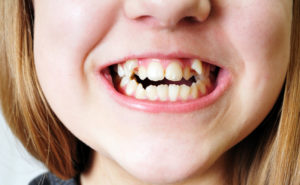
The American Association of Orthodontics recommends that children have their first orthodontic visit by age 7 or 8 to prevent the progression of any orthodontic issues that may be present. Even if you do not detect any dental issues with your child, it is still important that they get evaluated early on so that their teeth and jaw development can be properly monitored. If you notice that your child has bite problems or protruding teeth, it is time for them to see an orthodontist. Bite problems, such as a crossbite, cause the jaws to develop unevenly, while protruding teeth can be fractured or injured much easier than normal teeth. For both children and adults, there are certain signs that you should look out for that may necessitate an orthodontic visit. Some of these symptoms include difficulty chewing or biting, jaws that shift or make sounds, grinding/clenching teeth, biting the cheek or roof of the mouth, protruding teeth, and facial imbalance or asymmetry (facial features out of proportion). Even oral habits, such as thumb-sucking, affect how the mouth develops and can necessitate orthodontic treatment. For many patients, orthodontic treatment isn’t necessarily needed but is wanted to improve self-confidence and give them a prettier smile. Whatever your reason is, orthodontic care can help you reach your goals and improve your oral health at any stage in life.
How You Can Start
After you make the decision to begin orthodontic treatment for yourself or your child, the first thing to do is schedule an appointment with your orthodontist for a consultation. This consultation will allow both of you to establish appropriate goals, address concerns and develop a treatment plan. Additionally, taking good care of your teeth at home by maintaining an oral health regimen is important to keep your teeth healthy and prepare them for orthodontic treatment. Consistent brushing and flossing each day will protect your teeth and gums from plaque, tooth decay and cavities. During orthodontic treatment, it’s essential to maintain this routine to avoid any complications from occurring, which can extend treatment time and be costly to fix.
If you have questions regarding orthodontic treatment for yourself or your child, call Belmar Orthodontics at (303) 225-9016! Our talented staff is dedicated to you and your oral health goals, and will strive to help you get the beautiful smile that you deserve!
Why You Need Both a Dentist and Orthodontist
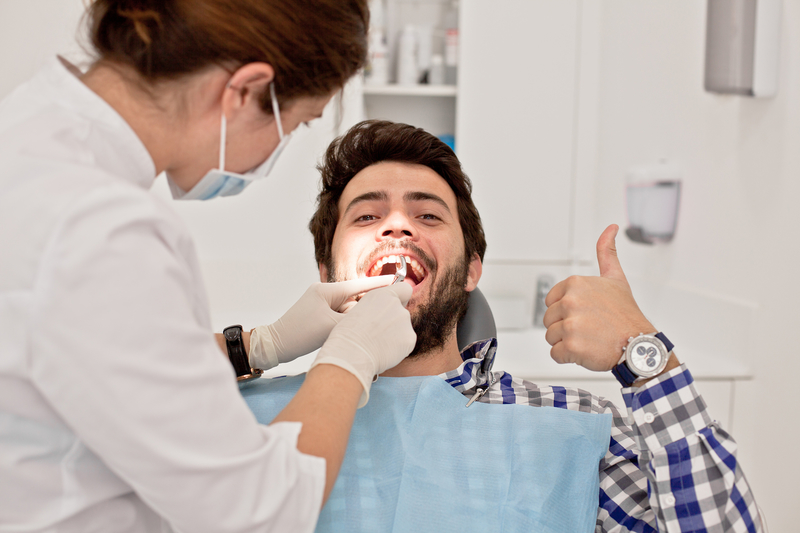
Dentists and orthodontists are both highly-trained professionals that can transform your smile. However, they provide completely different services to patients and both may be needed to help get your smile as healthy as possible. Orthodontic treatment connects to dentistry in many ways, as do the professionals themselves. If you’re like many others, you may need both professionals to keep your oral health in check.
Your Oral Care
Did you know that your oral health can affect all other aspects of your health? This is especially true if you already have some chronic conditions such as diabetes and heart disease. If your oral health isn’t taken care of, your overall health can worse and you are more susceptible to infection. If you don’t control chronic conditions, your oral health can worsen, as the blood vessels that nourish your teeth and gums can become damaged. Your teeth are more likely to decay and get infections that lead to tooth loss.
That is why taking care of your oral health is so important. It can help determine the state of your overall health and if you keep your teeth for a few years or for many. Many people need both an orthodontist and a dentist to help keep their mouth healthy. Not everyone needs an orthodontist alongside their dental care, but millions do. At least 4 million are getting braces each year in the United States alone to correct bite, alignment and problems with the teeth that lead to oral health diseases. When oral health care is happening at home, yet gum disease tooth decay continue to happen, it’s time to also seek help from an orthodontist.
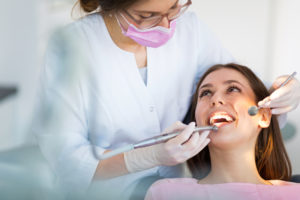
How Can a Dentist Help You?
A dentist is a professional that every person needs. Dentists are vital to you having good oral health for life. They can detect the presence of tooth decay, gum disease, oral cancer, oral sores and any other oral problem, plus they do the work to help correct those issues. These professionals go to school for 10 years just learning about your mouth and facial structures so they can help you stay healthy. Orthodontists receive all that same training, plus 2-3 extra years learning about straightening teeth, bite and alignment issues and structural problems with the mouth.
Because these professionals do different work, you will probably need both. Dentists have the primary duty to find the presence of tooth decay (cavities) using digital and x-ray technology. Then they have many different procedures to remove decay, fill the cavity, and restore your smile. They can do cosmetic work to make your smile look better and they deal primarily with oral health diseases and helping you avoid them so you don’t have early tooth loss. Orthodontists are trained to see cavities and oral health issues, but they will do structural work to help change your smile instead of dealing with the disease aspect of your oral health. Their work focuses on prevention of those issues in the first place.
How Can an Orthodontist Help You?
Did you know that people have had orthodontic care at least since the time of the Ancient Egyptians? More discoveries are finding orthodontic appliances on teeth thousands of years ago. Why? Because people that long ago also understood the benefits of straighter teeth. It took many centuries for orthodontists and orthodontic work to become established.
Studies found that straighter teeth made dental issues less likely to happen. When patients received orthodontic straightening—even through crude methods—they were less likely to have their teeth decay or break and less likely to have gum issues. The same holds true today. Crooked teeth are teeth that are much harder to clean. In a straight, even bite, the top front teeth rest just slightly in front of the bottom front teeth. From the front to the back, the teeth rest evenly on one another, evening out pressure from biting, chewing, eating, talking and more.
When the teeth are crooked, patients will get areas where they simply can’t get a toothbrush or floss to and those areas decay. The teeth may be at odd angles, and with uneven pressure placed on those teeth all the time, they may simply break. If you have crooked teeth, an orthodontist can easily make a plan to straighten them. Using digital x-rays, an orthodontist can examine your bite, alignment and incoming teeth and can make a plan to ensure all your teeth line up for the best oral health you could have.
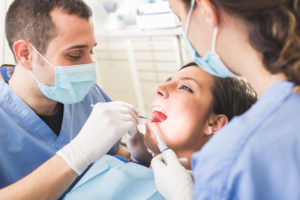
Do You Need an Orthodontist?
Not everyone will need an orthodontist, but their care can benefit most people. Even getting slight straightening of the teeth can reduce your dental breaks, emergencies and issues with oral health diseases. Orthodontic care can even help with bad breath if that stems from plaque and bacteria in the mouth that you can’t quite get rid of. To know for sure if you need an orthodontist, make sure to schedule an examination.
For children, the national recommendation by groups such as the American Association of Orthodontics is to visit an orthodontist around age 7 or 8. This is a key time for an orthodontist to be able to tell if the incoming adult teeth are coming in at the correct angle and place in the mouth. Oral health issues that can become severe later on in life can be caught early and childhood and many oral problems can be prevented with some orthodontic care. For all other issues with finding and filling cavities, gum disease, sores and more, make sure to call your dentist. To schedule your consultation with the orthodontist, call Belmar Orthodontics today at (303) 225-9016!
Braces Can Change Your Life
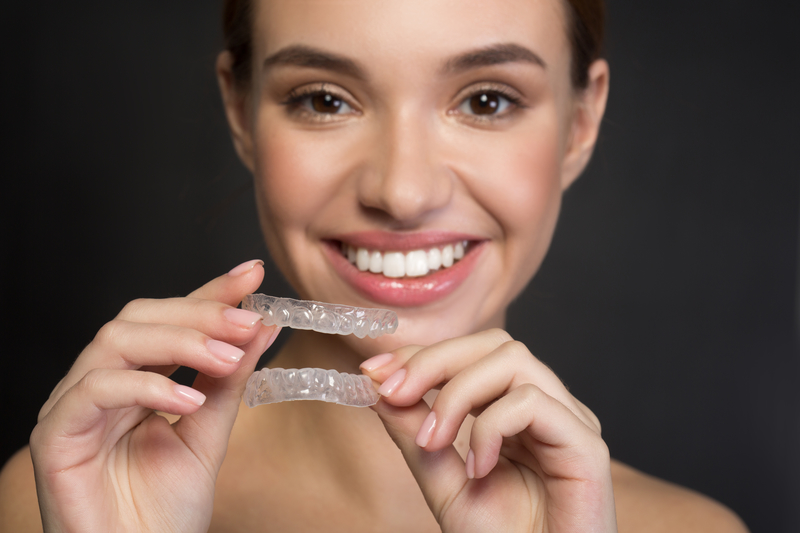
Your oral health can determine much of your overall health. Food and substances enter through your mouth, affecting your waistline, your appearance and your health. Your oral health can improve your overall health when you make changes in oral hygiene and bite and alignment. Misalignments in bites and crooked teeth can cause health and social problems, as they can lead to speech impediments, oral health diseases, and worsening chronic conditions. With braces, you can not only change how healthy your mouth is, but can change your life too!
Growing In Straight Teeth
Many people picture teens when they think of braces. However, 1/4th of people with braces are kids. Child orthodontics help straighten out teeth that would cause them speech problems, broken teeth and trouble growing in the permanent teeth. Adults and teens usually get them for crooked teeth.
However, braces aren’t just for people with crooked teeth. You may see patients young and old that appear to have a straight smile and yet they have to get braces. In this case, there is probably an oral health issue with the bite or alignment. Your teeth should line up along both the upper jaw and the lower jaw. When you go to the dentist, they will ask you to bite together so that they can view how your bite rests. How your teeth sit when they are resting together can determine if you will have dental issues and even speech impediments. This is especially true for young kids who are losing baby teeth and having adult teeth grow in.
Children have their baby teeth for years—even up to age 12 or later at times. Those baby teeth start to space out a bit more as a child grows from an infant to a school-aged child. Their mouth grows with them, making room for adult teeth. 20 baby teeth will become 32 adult teeth (including the wisdom teeth). However, those teeth don’t always come into the mouth in the right position or the right direction. With a healthy bite, the upper and lower jaws should have the teeth lining up evenly with one another. The teeth should be straight up and down, and the front upper teeth will rest just slightly in front of the bottom front teeth.
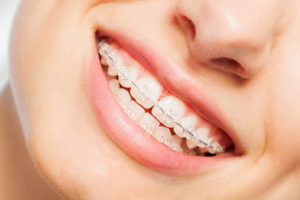
Braces Can Prevent Dental Injuries
When teeth aren’t straight and they jut out at different angles, it can mean broken, cracked or chipped teeth in the future. Those dental injuries would be caused by uneven pressure on certain teeth which will eventually break them or will cause areas of decay that you can’t clean well. The alignment of the teeth can also cause speech impediments when forming words, and those impediments can last for life if bite, alignment and crooked teeth aren’t corrected. For young children and adults alike, receiving braces for these issues can certainly change not only their oral health, but their life.
Braces are sometimes needed to make space in a patient’s mouth. Not all mouths grow to fit the incoming teeth, but that doesn’t mean the adult teeth won’t stop coming in. All your teeth will come in, even if they have to crowd out other teeth. That crowding can be painful and even one tooth coming in where there isn’t room can cause all of your teeth to go crooked. As a tooth comes in, it will slowly push other teeth from the area, which then have to shift. This is what wisdom teeth commonly do, and it can be painful as it messes up a smile. Braces can stop that from happening by making plenty of space in the mouth for teeth that are still coming in.
What If You Have Your Teeth Already?
The dental issues we have mentioned will generally happen before a person has reached adulthood. The American Association of Orthodontics recommends that children have their first orthodontic appointment around age 7 or 8. This is when we can see how the baby teeth are falling out and how the permanent teeth are coming in. We stop dental issues before they start forming, and during this time when the jaw bones are still soft enough to mold. However, at least 1/4th of patients that have braces get them when they are adults. The jaws have grow completely and have hardened into place by adulthood, making orthodontic treatment harder.
However, we said “harder”, not “impossible”. Orthodontic advancements can definitely help an adult change their smile to change their life. Now, more than ever, it is becoming increasingly important to have a straight smile as an adult. Studies show that others make an opinion of you based off of the first few seconds of meeting you. Your appearance can go a long way. Your smile is also one of the top 3 features others will notice first when formulating an opinion about you. Studies show that those with straighter teeth are seen as more attractive, successful, smart, healthy and trustworthy. Employers are more likely to hire those with straight smiles over those who don’t have them.

Your Options
If you’re an adult, you can straighten your smile without it being noticeable. Children often go the route of traditional metal braces or ceramic braces, which are the same but made from ceramic material. Adults and many teens opt for hidden options like lingual braces or Invisalign treatment. Lingual braces are metal braces that attach behind the teeth, staying hidden as they correct bite, alignment and your teeth. Invisalign treatment consists of transparent aligners patients change out every week. However, they don’t do as well with larger bite and alignment issues. It’s never too late to receive orthodontic treatment.
Whether you are young or old, you can change your smile to reduce or eliminate your problems with speech, tooth decay, oral health issues, dental injuries and to even feel more attractive. Want to see just how much braces can change your life? Call Belmar Orthodontics today at (303) 225-9016 to receive your free consultation!
How Bite Correction Can Change Your Life?
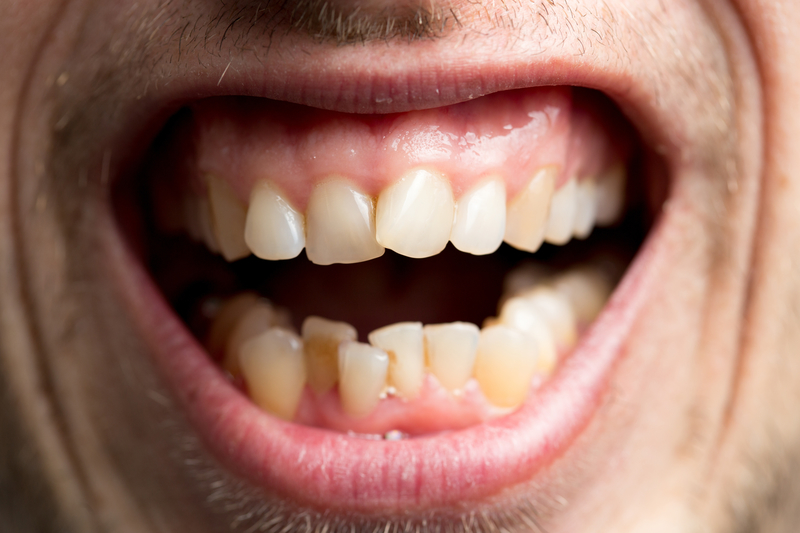
Do you or your child have a problem with their bite or alignment? These problems can seem small at first. However, as a child grows into an adult, bite or alignment issues could cause many health problems. It can even cause speech impediments and difficulty chewing in the future. Find out how bite correction can improve your health and just how important it is to get bite correction via braces if you need it!
Your Bite Should Be a Certain Way
The structure of your mouth is defined by how your teeth and jaws are formed. Your upper jaw and your lower jaw should both follow the same arch in a U shape. Those arches should also line up together. The teeth as well, should lie on top of one another evenly, with your back top molars resting on your back bottom molars all the way towards the front. In a normal bite, the front top teeth will rest on top of your bottom teeth, except they will be just slightly in front of those bottom teeth.
Orthodontic care is not just for teens that are looking to get a straighter smile. In fact, about 1/4th of all people that wear braces are actually children! The American Association of Orthodontics recommends that children have their first orthodontic visit between the ages of 7 and 8. Having an examination early-on helps prevent the progression of orthodontic issues, such as a misaligned bite. How a child’s mouth is forming is a great indication of what their mouth will look like as an adult. If we can already see that their teeth are growing at the wrong angles, or that their jaws don’t line up, we can predict that oral health issues will be present in the future. That is why having this orthodontic appointment at 7 or 8 is so important.
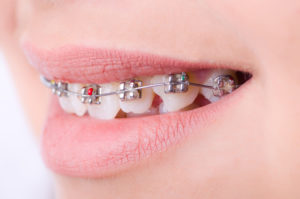
Types of Bites
When a child comes in to have their mouth examined, we can see how the top and bottom jaws line up. In a mouth with correct bite formation, the jaws will line up. If they do and the teeth are not coming in at crooked angles, then a child won’t need orthodontic care unless they want to straighten their teeth later on in life. However, prompt treatment will be needed for alignment and bite correction if a child or older patient has:
- Overbite – The upper front teeth overlap too much over the bottom front teeth.
- Underbite – The upper front teeth rest behind the bottom front teeth.
- Crossbite – Teeth are at varying angles in the mouth, which can lead to decay, broken teeth and speech problems.
Benefits of Bite Correction for Children
The ideal time to receive any treatment for bite correction is during the childhood years. This is when the mouth and jaws are still growing. Because the bones aren’t set yet, it is much easier for an orthodontic appliance to mold a bite into the correct shape without too much effort. This is generally why a child would receive bite correction treatment before they are 10 years old.
If a child receives bite correction via braces, they benefit from their mouth forming correctly. Where there were once speech problems developing, their speech can start to sound normal without lisps or other impediments. Facial features will appear more normal because the structure of the mouth will be maintained with orthodontic appliances. In a child with severe bite problems, some people can physically see parts of the jaws jutting outward. This makes the face look different than it should, and speech will almost certainly be compromised. We stop that incorrect shaping before the jaws harden later on and before dental diseases and problems are developed.
Even if you don’t detect any dental issues with yourself or a child, there are still many advantages for bite correction and braces at an early age such as:
- Observing the progress of incoming teeth
- Monitoring facial and jaw development
- Guiding incoming teeth into their ideal position
- Detecting hidden dental issues
- Reducing the risk of impacted teeth
- Decreasing the risk for permanent tooth extractions (as teeth won’t get uneven pressure that breaks them)
- Reducing the risk of cavities and gum issues that happen when the teeth are crooked and harder to clean
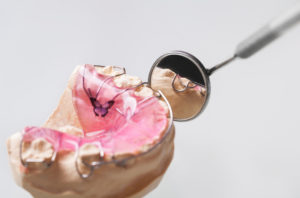
Benefits of Bite Correction for Adults
If you didn’t receive orthodontic care as a child, it is not too late to receive it later on in life. Adults and teens make up the other 3/4ths of patients that get braces. At about age 11 or 12, most of the permanent teeth should be in the mouth. At this time, we can look at a patient’s teeth and see if they need their teeth straightened. When bite problems are present (because child orthodontics was not done), it is harder to do them as teens and adults, but it can be done with normal orthodontic appliances. In some cases, some surgery may be done to reshape areas of the mouth that have hardened into place.
However, the benefits of bite correction and tooth alignment for teens and adults is astounding. Studies show that people perceive you as more successful, healthy and happy if you have straighter teeth than if you have crooked teeth. You’re more likely to get a job over someone that has crooked teeth, because your smile is an expression of your health and how well you care for yourself. That can translate into how well you care for other things, like your obligations.
Studies show that in adults and children alike, that confidence soars and smiles are shared more often when people feel good about their smiles. That confidence boost can change your entire outlook on life, and can lead you to be a more successful person than you otherwise could be. If you have teeth in need of bite correction or straightening, don’t hesitate to see what orthodontic care can do for you! Call Belmar Orthodontics today at (303) 225-9016!
How We Plan Out Your Orthodontic Treatment

Even though most patients have braces for about 18-24 months, every patient’s care is different. Orthodontic treatment for one patient may be extensive, while another patient will have a very short and simple experience with braces. Find out how Dr. Hardy plans out your orthodontic treatment and how that treatment will look with different braces appliances.
Do You Need Braces?
Countless millions of people will require orthodontic treatment in order to fix bite and alignment problems. They also get braces to fix crooked teeth and to reduce problems with tooth decay and gum disease. Over 4 million Americans a year receive orthodontic treatment via braces. Many of those people are teens, but about 1/4th are children and about 1/4th are adults. Studies show that many people see braces as a luxury and even go without many needs and wants in order to have them. This is not only for aesthetic appeal, but also for health reasons.
Countless studies prove that orthodontic treatment can help make a person more confident. When your smile is beautiful, you will smile more. Smiling will help you feel happier and more confident, and you will actually start to appear that way to others. Studies also show that people with straighter smiles as viewed as healthier, wealthier, more attractive, and more trustworthy. If all of those qualities appeal to you, consider receiving orthodontic treatment. If you have oral health problems as well, you may actually need braces to help those problems stop.
Orthodontic Treatment for Children
We perform child orthodontics for many patients. Development in children is vitally important in the younger years before age 10. Children lose their baby teeth around ages 7 and 8. They immediately start to have their permanent, adult teeth come into the mouth. This is a time when we can examine a child’s bite and alignment to make sure the adult teeth will come in correctly.
Some children don’t have enough room in their mouth to have their adult teeth grow in or they grow in crooked. This can lead to significant problems with speech impediments. If the teeth are crooked, this can place uneven pressure all over the mouth, leading to broken, cracked and chipped permanent teeth. Crooked teeth also lead to pockets of plaque that toothbrushes and floss can’t get to. This leads to decay problems. Straightening the teeth with orthodontic treatment can not only fix bite and alignment issues, but can straighten the teeth in childhood, so they come in correctly as a child grows.
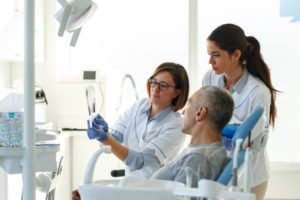
Orthodontic Treatment for Teens and Adults
For children, we take x-rays of their teeth to detect bite and alignment issues. We show our patients problem areas in their x-rays and suggest orthodontic appliances to best realign the bite and alignment of the jaws. For children, teens and adults, the teeth will be straightened to avoid serious dental problems. We offer 3 types of either metal or ceramic options to patients for their orthodontic treatment including metal braces, lingual braces and ceramic braces. All consist of a bracket-and-wire design, but all are different.
Depending on your preferences, you can choose to have either metal or ceramic brackets and wires on your upper and lower teeth. Or, you can choose to have metal lingual braces, which are metal braces placed on the backs of your teeth. Once you choose your orthodontic appliance, we take impression molds of your teeth. Those molds will harden and we will use them to plan out a trajectory of your orthodontic care. Based off of how crooked the teeth are and what appliance you choose, we will break down your orthodontic treatment into a series of months and will see you every 4-6 weeks to tighten wires on your teeth in order to move the teeth during that timeline. When you get your braces, you will also get all the information you need about your chosen braces appliance and what timeline you can expect for your straightening.
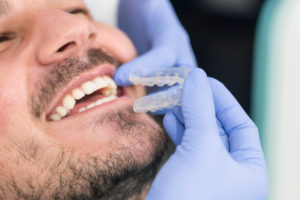
Invisalign Treatment
In decades past, traditional metal braces were the only option given to patients. In modern times, many teens and adults are opting for more and more discreet straightening options. The most invisible method for receiving orthodontic treatment is through Invisalign transparent aligners.
Invisalign is a fairly modern orthodontic treatment where the teeth are straightened with transparent aligners instead of the traditional metal wires and brackets. Invisalign teen and Invisalign for adults are both comprised of custom-made aligners that a patient changes every week. We digitally design Invisalign aligners based off of digital impressions of a patient’s teeth. Using this initial impression, we can digitally map out a patient’s orthodontic treatment. This is beneficial to teens and adults alike. They can visually see how their teeth will change over the months and how the end result will be. Plus, no goopy putty required!
The hard Invisalign aligners efficiently place pressure on the teeth and slowly move them into place over time. Instead of tightening brackets and wires at orthodontic appointments, patients receive new aligners and have their teeth examined to see if they are on course with their treatment. This treatment option lasts about as long as traditional metal braces, but can be shorter for many patients.
Choosing Orthodontics That Are Right for You
If you are considering getting orthodontic treatment, don’t wait! A straighter smile has incredible benefits for children, teens and adults alike. Straighter smiles bring more confidence to people, and others will see that confidence. To learn about what orthodontic treatment option is right for you and to get started on your customized plan, call Belmar Orthodontics today at (303) 225-9016!
Choosing a Good Orthodontist
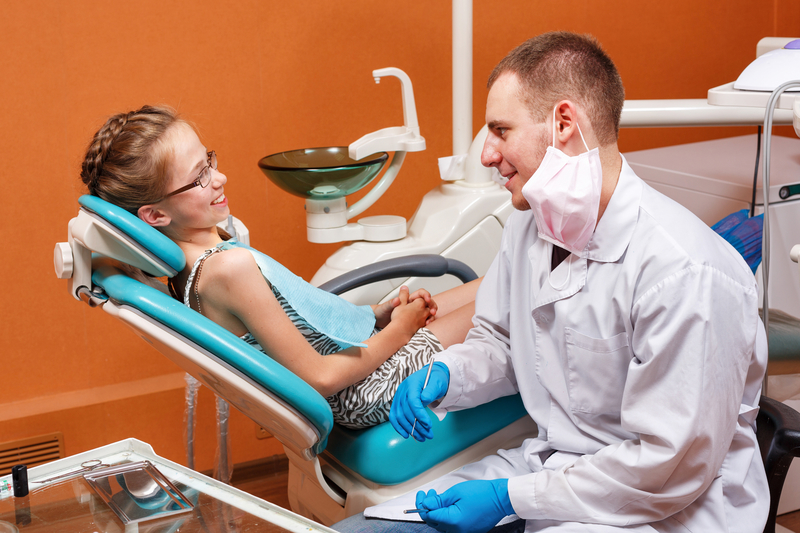
There are many orthodontists out there, but not all are created equal, and not all have the same training or experience as others. Just like dentists, only some are award-winning orthodontists (for good reason), while others are not. A good orthodontist needs to have specific training and credentials to work on your or your child. Their office needs to have specific equipment to perform the necessary work, and a good orthodontist will provide a wide range of services for their patients. Find out what a good orthodontist looks like and how to choose a good one from one you want to avoid!
Choosing to Receive Braces
If you have made the choice to get braces, we commend you! Braces is an amazing way to change your life for the better. Studies show that straightening your smile is directly related to increased confidence. The better a person’s smile looks, the more they smile and the more confident they appear to others as well. Studies by Invisalign and countless others have found that a straighter, more beautiful smile makes you appear happier, healthier, wealthier, and more attractive to others. 73% of people are also more likely to find you trustworthy.
Now that you have chosen to embark on this new journey of getting braces, you have to decide who you should get your orthodontic care from. All too often, dental practices have started offering orthodontics via transparent aligner systems or Invisalign. Even though we offer Invisalign at our center (and it is effective), the majority of dentists are not trained to perform orthodontics. It’s similar to a spa offering botox injections instead of a medical doctor that provides botox injections. They may have some training in oral health and dentistry, but dentistry is not the same as orthodontics.
You always want to choose a trained orthodontist to provide you orthodontic work, and not just a dentist (or even someone without a degree) to perform any work on your mouth. If you do, you take a serious health risk that your teeth will be messed up permanently or that you will have oral health complications. Always go to a certified and trained orthodontist for your orthodontic work.
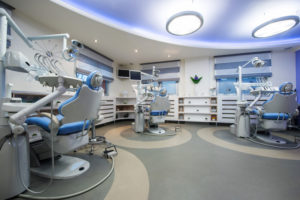
Training to Become a Good Orthodontist
Becoming a good orthodontist takes many hard years. A good orthodontist will receive an undergraduate degree and then will go on to be accepted into dental school. A good orthodontist will receive high marks in their dental school, and will have to be accepted into an orthodontic school afterwards. Some even go beyond their 10 years of base training to do fellowships and additional study. It takes an entire decade to learn how to straighten the teeth properly, even if orthodontic care may seem simple and straightforward.
Orthodontists deal with the health of a person’s mouth, which can affect their overall health, their confidence, and even if they are at risk for tooth decay, gum disease and more. Working with children in orthodontics can be even trickier, as many children require specific work to make space in the jaws for incoming teeth.
What Is Their Experience with Children?
The majority of good orthodontists work with children on a regular basis. However, there are some that have better training than others. You always want to look for a good orthodontist that has training to work with a child on their intellectual level. Children sometimes fear dental or orthodontic office or having work done on their mouth. We strive to provide a child-friendly atmosphere to our young patients to make them comfortable during their treatment.
A good orthodontist is one that can help your child feel at ease and confident about the smile they are getting. When choosing an orthodontist, observe how they act with your child. If they are warm and inviting, this can help children have a positive orthodontic experience for early orthodontic treatment and when they receive braces for straightening later on.
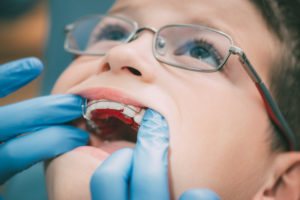
What Qualities Do We Have?
If you want a good orthodontist, give Belmar Orthodontics a try! Dr. Hardy is an award-winning orthodontist that treats patients at two different locations. He has extensive training in dentistry and orthodontics and actually runs a pediatric dentistry and orthodontics office alongside his wife. He treats pediatric patients and older at Hardy Pediatric Dentistry & Orthodontics and he treats patients of all ages at Belmar Orthodontics. Dr. Hardy offers every option available in orthodontics to his patients. That includes traditional metal braces, lingual braces, ceramic braces, Invisalign and Invisalign Teen, as well as retainer devices, TADs, and surgical orthodontics. All of these services required countless hours of training, testing and performance to become certified.
As we mentioned, you want an orthodontist who has won awards and who others are talking about. Dr. Hardy is board-certified by the American Board of Orthodontics. He is also an active member of the American Dental Association and the American Association of Orthodontics. He received the Everett Shapiro Award in Orthodontics as well as the Dr. Harold Berk Endowed prize Fund for Excellence in Research. He is also a member of many dental organizations that you can find here. He is extensively trained to work not only with teens and adults, but also children—even very young ones. Dr. Hardy also works alongside his wife often, who also has extensive training and psychology experience with young children.
We can talk about Dr. Hardy’s qualifications all day long, but the best way to know what a good orthodontist looks like is to come into the office and see for yourself. To schedule your free consultation or to learn more, call Belmar Orthodontics Orthodontist in Lakewood Colorado today at (303) 225-9016!
Oral Health Facts for Children and Adults

Did you know that what you eat makes a major difference in how healthy your mouth is? What you eat can determine your likelihood for tooth decay and other oral health diseases. Did you know that your teeth also aren’t bones like many people think? They are made of an entirely different substance even though they are hard like bones. Find out oral health myths and facts that exist, how to care for your teeth properly, and some facts about orthodontic care!
Are Your Teeth Bones?
Many people think the teeth are bones, but they aren’t. They are hard like bone, but are actually harder. Teeth are the hardest substance in your body, as they are made up of about 96% mineral. Bones have a more sponge-like interior and aren’t solid mineral. However, your teeth and bones are made of similar materials such as calcium and phosphate, which is why they are both so hard.
Facts About Your Teeth
Infant and adult teeth are not the same:
- Infants are not born with their teeth. Most start to get teeth between 3 and 9 months of age.
- Children can receive their teeth up until age 3. Some will get all their teeth within a few months, whereas others get them slowly one-by-one.
- Children only have 20 baby teeth compared to an adult’s 32.
- As soon as a child gets a first tooth, it needs to be brushed at least twice a day. Infants also need to see the dentist within 6 months of getting their first tooth.
- Bite and alignment problems in children are best treated around ages 7 and 8. This is the recommended time for children to visit an orthodontist. If bite and alignment problems are present, child braces can correct the problems before they become severe later on.
- Children get their teeth in a certain order: the bottom front 2 teeth, followed by the top 2 teeth. Then, the next tooth on either side on the bottom jaw, then the next two on either side on the top jaw, etc.
- Children lose their teeth in the order that they came into the mouth. Losing the baby teeth makes way for the adult teeth to start coming in once a child has grown larger.
- Adults will have 32 total teeth. Most will have the 4 wisdom teeth taken out, which drops that total number down to 28.

Brushing and Flossing
Many people brush their teeth but don’t see the importance of flossing. Plaque doesn’t go away unless you physically remove it with brushing and flossing. Only brushing your teeth is like only cleaning the outside of a car and never the inside. The inside parts can fill up with gunk, just like the spaces between your teeth. Flossing is especially important during your time with braces. Not flossing could land you with cavities or cratered parts of your teeth when braces come off.
Avoiding the Dentist or Orthodontist
“The dentist/orthodontist is scary”. Although many think the dentist is scary, it’s not actually. Some people fear going to the dentist, even though the dentist is someone who is only interested in helping you be healthier. Going to the actual dental office can evoke negative feelings if you’ve had a bad experience. This is why sedation dentistry was created. This is a form of dentistry where you can receive sedation during your procedure to help make it a more positive experience. If you think the dentist (or the orthodontist) is scary, we can help it be less scary. That’s especially because an orthodontist won’t have needles and drills at your appointment. They either put your braces on or tighten them for you. Not so scary, right?
Myths About Orthodontic Care
There are many myths about orthodontic care that could hurt you if you’re not careful. You want to always seek out the best care for your teeth and receive that care from a trained professional.
- Providers who offer orthodontic treatment are orthodontists: false. Now, more than ever, there are many dentists or oral health professionals that are starting to offer orthodontic treatment. Many offer this treatment in the form of Invisalign aligners. This is a great system for straightening the teeth, but only if you have the right training. Orthodontists are specifically trained to straighten your teeth correctly. Dentists are not unless they have specifically received schooling and training in orthodontics. Check credentials before you let someone touch your teeth.
- Braces are too expensive: false. Braces aren’t the cheapest purchase in the world, but they can benefit you more than most other things you’ll ever invest in. Many insurance plans work with patients to make braces affordable, and we do the same. We want as many people as possible to receive orthodontic care. If you think they are too expensive, give our office a call and we will work with your budget. Any person can receive great orthodontic treatment if they work closely with an orthodontist.
- Braces are only for children: false. Studies show that at least ¼ of people that wear braces (so about 1 million+ each year) are adults. Almost half of the people wearing braces are teens. So no, braces are not just for children. Adults also have several virtually-invisible options for orthodontic care such as transparent aligners and lingual braces. These options make braces a great choice for adults.

Great Oral Health
No matter the myths or facts you’ve heard about your oral health, the bottom line is that it’s important! How well you take care of your teeth will determine how good your health is and how much confidence you have in yourself. Studies show that people with straighter, more beautiful smiles are happier, healthier and more confident. You can have that confidence to no matter if you are young or old. To learn more about braces and proper oral hygiene while having them, call Belmar Orthodontics today at (303) 223-9016!
A Straight Smile for Life with Retainers
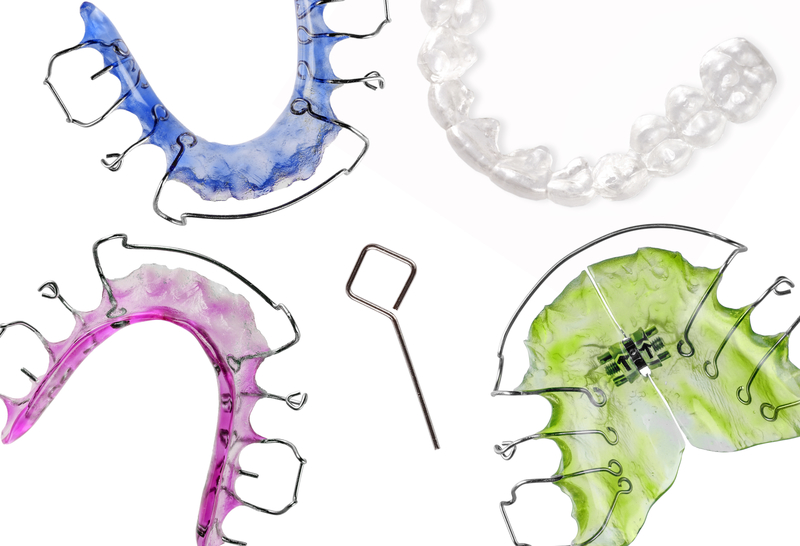
Most patients spend 18-24 months with their orthodontic appliances. That’s about 78-104 weeks of your life with braces, and time that you don’t want to have wasted. The worst thing that can happen after getting your braces off is that your teeth go crooked once more. This can happen within the first month if you’re not careful. Luckily, dentists know this and we provide our patients with either removable retainers or permanent ones. See why retainers are so important for maintaining a straight smile for life and why you need one!
Finishing Up with Braces
If you have gotten to the point in your orthodontic treatment that you need a retainer, congratulations! It has taken you 18-24 months to get that beautiful, straight smile you’ve wanted. No matter if you had lingual, ceramic, or metal braces, or if you opted for Invisalign treatment, you will still need an orthodontic appliance to keep your teeth straight. This isn’t something you want to wait on either, as studies show that your teeth start shifting back to their crooked state within the first month of getting braces off.
When our patients end their time with braces, we immediately prep them for either a removable or a permanent retainer. There are pros and cons to each of these types of retainers, but the bottom line is, you need one! A retainer is exactly what it sounds like; it “retains” your straight smile. When you wear it (usually at night), your smile won’t shift or become crooked. We take an impression of your teeth as soon as your braces come off, which we then send to our lab. You will have a retainer custom-made to fit your newly-straightened teeth that will keep them in that position for decades to come.

Retainers 101
You may need both a bottom retainer and a top one, or you might just need one. Some dentists only require a bottom retainer, as the bottom teeth tend to keep the top teeth in place. It all depends on the patient. As we mentioned, there are two types of retainers: removable and permanent.
- Removable – These are the classic retainer pieces that most people think of when they think “retainer”. When we make impressions of your teeth, we go back and use those impressions to make retainer pieces for your top and bottom jaw. Once they are done, you will come into the office and try out your new retainers. Wear them every day during the night and clean them when you take them out in the morning. Only use cleaning products that are safe for mouth retainers and never use hot water when cleaning.
- Permanent – This is also a “fixed” retainer because it is bonded to your teeth and set in place. Much like your braces (if you chose ceramic, lingual or traditional metal), we will bond metal parts to your teeth. However, these metal parts will be placed on the back of your teeth instead of the front. You can choose to have a metal bar that goes across the back teeth or you can choose small metal wires that will bond each individual tooth to the one next to it. If you choose the second, you will have the bottom 6 teeth connected, with bonding cement on each of the backs of those 6 teeth. However, the metal and bonding is small, so it won’t take up very much room in your mouth. You may not even notice it! Both the bar and series of small wires work to keep your bottom teeth in place, which will keep your top in place.
Which One Is Right for You?
Our patients can choose if they want to have a removable or permanent retainer. One might not be right for a patient depending on age and daily habits. If you often lose things (such as car keys or your phone), then you might want to choose a permanent retainer. These stay in place 100% of the time and because of that, you can never lose them. Plus, they retain your teeth around the clock, instead of only at night (like a removable retainer). Permanent retainers also aren’t visible like removable retainers are because they are attached behind your teeth.
A removable retainer will have visible bars that others will be able to see in your mouth when you show your teeth. This generally isn’t a problem, as most people wear theirs at night. If you already struggle with brushing and flossing your teeth, you might opt for a removable retainer, as flossing can be more difficult with a permanent retainer. However, both options are great for all our patients. You simply have to choose which one fits you best.

Healthy Life, Healthy Mouth
We would love every single one of our patients to have a straight smile many decades from now. If you wear your retainer like you should, or continually renew your permanent ones, you can count on keeping that straight smile. However, you also want to keep your smile healthy and free of disease throughout all those decades. After all, there is no point in striving for a straight smile if you don’t have any teeth!
No matter if you are 9 or 90, you have to keep up on proper oral hygiene practices if you want to have a healthy, beautiful smile. Brush and floss your teeth every single day, making sure to brush multiple times a day. Eat nutritious foods and cut down on the sugar to reduce your risk for tooth decay and gum disease. Also, clean your retainer every day so that it stays strong and durable for many years. If you need a new retainer, or are interested in a permanent retainer option, call Belmar Orthodontics today at (303) 225-9016!
What are Palatal Expanders?

Palatal expanders—usually worn by preteens—are commonly used to widen the jawbone and help treat certain orthodontic conditions. Expanders help prevent tooth extraction and can sometimes shorten the time needed for orthodontic treatment. Expanders may sound extreme, but arch expansion is one of the most common ways to eliminate crowding and crossbites in growing patients. While adapting to a palatal expander usually takes a day or two, it may take up to two weeks. Learn all about palatal expanders and how they can help your orthodontic care!
Infant Teeth Vs. Adult Teeth
A child’s mouth is not like an adult’s mouth. An infant will begin to get their teeth between 6-12 months. They will have the bottom two front teeth come in first, followed by the upper two front teeth and so on towards the back of the mouth. These teeth will be spaced out more than the adult teeth and there will only be 20 instead of 32 like an adult has. The spaces will allow growing room in your mouth for the permanent teeth to come in once your child is old enough to get them.
Between the ages of 6 and 13, your child’s baby teeth will begin to fall out in order to make way for the adult, permanent teeth. This is an exciting time, as your child is beginning to grow into a teenager, where they will have adult teeth. This childhood time of growing is the easiest time to fix bite and alignment problems.
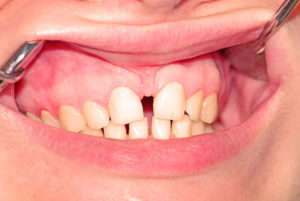
Child Orthodontics
We not only do orthodontic treatment for adults, but also for children. The American Association of Orthodontics recommends that children have their first orthodontic visit between the ages of 7 and 8. Having an examination early-on helps prevent the progression of orthodontic issues that can become severe as your child ages. We mostly look for proper bite and teeth alignment, but we also make sure that there is enough room in your child’s mouth for the adult teeth to come in properly.
If we find that your child’s bite is not aligned, we will fit them for braces. This will bring their bite back into proper alignment, thus reducing the risk of crooked and broken teeth, speech impediments, problems eating and chewing, and problems with the adult teeth. We refer to this early orthodontic intervention as “child orthodontics”. Some patients have a small mouth with a small palate. A small palate can cause many health problems, which is why we have a service for palatal expanders.
What Are Palatal Expanders?
Some children’s jaw’s aren’t big enough for their incoming adult teeth. Sometimes, removing a tooth is the best option for a patient to make room for their adult teeth. However, we like to try palatal expanders first to make extra room in your mouth without removing a tooth. The palate of the mouth is the roof of the mouth above the tongue. That’s where palatal expanders are used. These are appliances that stretch parts of your mouth where bone and cartilage lie so that more room grows in your mouth. Palatal expanders are generally used if there is enough bone and gum tissue around the teeth. If not, a tooth is removed instead. There is an upper and lower jaw palatal expander, which do the following:
- Upper Jaw Palatal Expanders – An expander in the upper jaw of the mouth seeks to stretch the bone and cartilage of your palate. Expanding this area will grow and stretch a child’s arch so there is room for all the adult teeth. Making this extra room through natural stretching will prevent crowding of the teeth as well as cross bite problems in children. Palatal expanders in the upper jaw are actual appliances we stick in your mouth to stretch this area. We attach the expanders to your back molars with metal rings. In some patients, the attachments are removable. As a child’s mouth expands, you may notice a gap starting to form between the two front teeth. This is normal and their appliance is in for several weeks or months.
- Lower Jaw Palatal Expanders – This type of expander will simply moves the teeth if they are tipped inward instead of straight up.
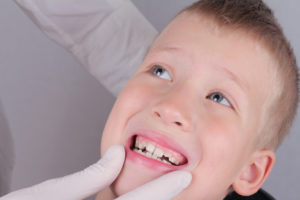
Additional Appliances
There are also other devices we use in certain cases when it comes to orthodontic care. Some patients will need TADs to help shift their teeth into a straighter position. These are “Temporary Anchorage Devices” that are mini titanium screws. These are sometimes referred to as “mini-implants” or “micro-implants”. They are screws that provide a fixed object that is used to push, pull, lift or intrude teeth during the straightening process.
If you need tads, Dr. Hardy will carefully numb your gum tissue and jaw area before placing these tiny screws in your jawbone. With our local anesthesia, this procedure is completely painless and getting accustomed to your TADs only takes 1-2 days total. These anchorage mini screws will help your orthodontic treatment be faster.
A Straighter Smile for You
Dr. Hardy will evaluate your teeth to determine if palatal expanders, TADs and other appliances are needed for your teeth. Palatal expanders are needed before you receive braces and TADs are used during your time with braces. Palatal expanders is one step closer to a beautiful smile for our patients. If you want to know more or are ready to get braces, call Belmar Orthodontics today at (303) 225-9016!

